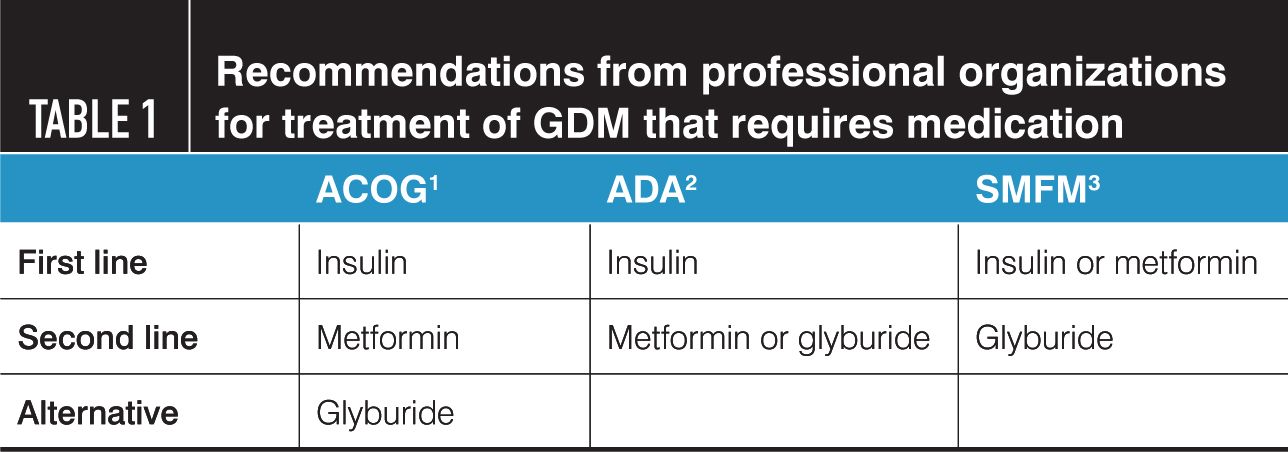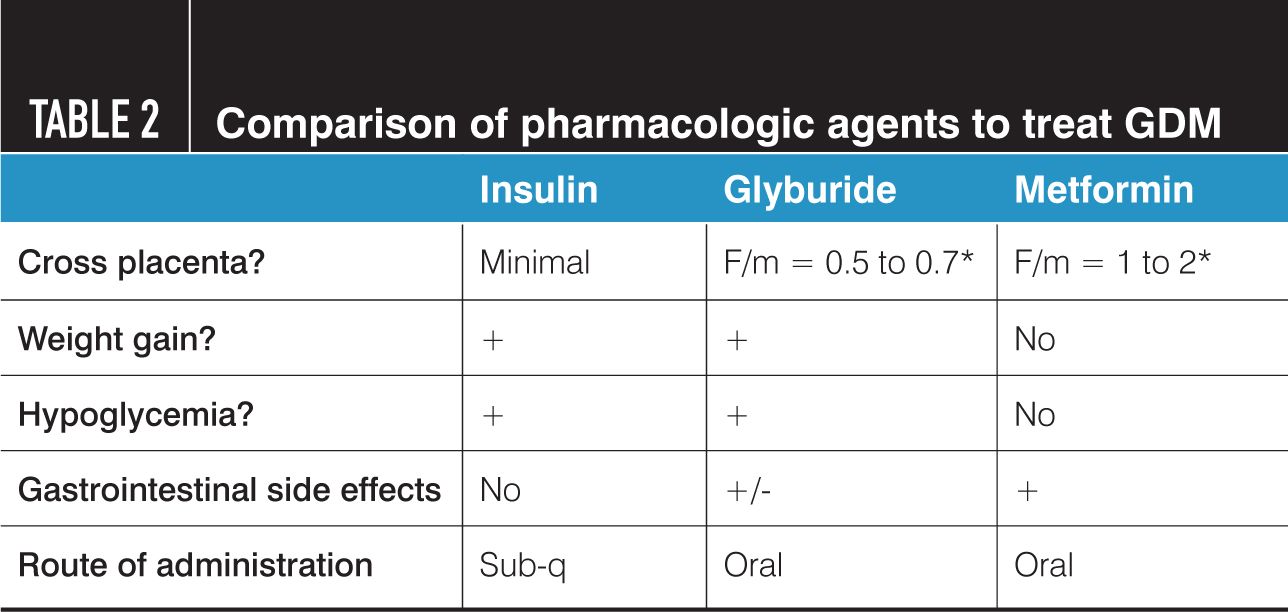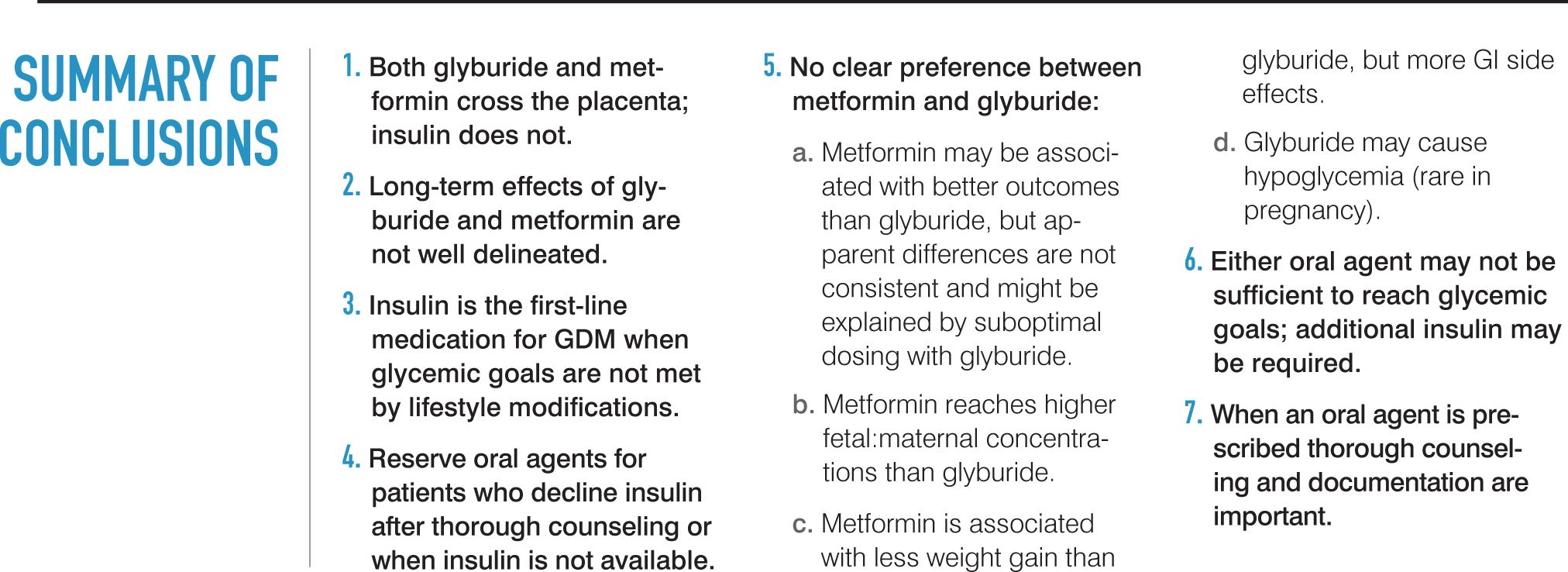Using oral antidiabetic agents to manage hyperglycemia in GDM
These drugs offer advantages over insulin, but limited data on their long-term effects warrant caution when prescribing.
Illustration by Alexandra Webber Baker, DNA Illustrations Inc. Click here to see more of her work.

Table 1

Table 2

Summary of conclusions

Gestational diabetes mellitus (GDM) is carbohydrate intolerance, short of overt diabetes, diagnosed during pregnancy. GDM is associated with adverse pregnancy outcomes, such as fetal macrosomia with its attendant risks of birth injury during vaginal delivery, neonatal hypoglycemia, plethora and hyperbilirubinemia, excess fetal/neonatal fat deposition, childhood obesity, and disordered carbohydrate metabolism. Maternal problems include an increased risk of cesarean delivery and hypertensive disorders of pregnancy. Many of these adverse outcomes can be prevented or ameliorated by efforts to maintain maternal euglycemia. Various professional organizations recommend lifestyle modification including diet and exercise with self-glucose monitoring.1,2 If goals for glucose control are not met, an antidiabetic medication should be prescribed. The Australian Carbohydrate Intolerance Study in Pregnant Women (ACHOIS) and the Eunice Kennedy Shriver National Institute of Child Health and Human Development (NICHD) Maternal-Fetal Medicine Units (MFMU) network randomized controlled trials (RCTs) demonstrated that identification and treatment of mild GDM reduces adverse outcomes.3,4 (In ACHOIS, the 2-hour 75-g glucose tolerance test [GTT] value had to be 140-199 mg/dL, while in the MFMU study the fasting value on the 100-g GTT had to be < 95 mg/dL.) Medication was needed in 8% to 20% of subjects. A higher proportion of patients with GDM require antidiabetic medications when the spectrum is not limited to “mild” GDM.
Related: Type 2 Diabetes In The Non-Pregnant Patient
Both the American College of Obstetricians and Gynecologists (ACOG) and the American Diabetes Association (ADA) recommend insulin as the first-line medication for treating GDM uncontrolled by lifestyle modification (Table 1).1,2 The Society for Maternal-Fetal Medicine (SMFM) considers insulin and metformin to be reasonable and safe first-line alternatives.5 None of these professional organizations recommend glyburide as first-line therapy. A review of pharmacy dispensing in over 437,000 pregnancies during the second and third trimesters between 2001 and 2007 reported that 70% of patients prescribed an antidiabetic drug received only insulin and 3% received only metformin, while 21% received another oral agent, mostly a sulfonylurea such as glyburide. An additional 5% received multiple agents.6 Another review comparing pharmacy data for glyburide and insulin to treat GDM reported that by 2011, glyburide was prescribed twice as frequently as insulin.7 Both of these publications were prior to the systematic reviews described below. A survey of MFM specialists published in 2017 reported that 57% use glyburide as their first-line treatment for GDM, 36% use insulin and 4% use metformin.8 This article will address these three medications for GDM: insulin, glyburide and metformin (Table 2).
Insulin
Insulin of various types is the longstanding first-line treatment when GDM glycemic goals are not met with lifestyle modification. There is minimal passage of insulin across the placenta, which is the primary reason why it is preferred for GDM. The major drawbacks of the drug include the requirement for subcutaneous injection and risk of hypoglycemia, which is unusual in GDM unless a meal is missed after an insulin injection. In addition, people with diabetes with significant glycosuria may gain weight when insulin treatment prevents loss of calories in urine. A description of various types of insulin and dosing paradigms is beyond the scope of this article and may be found elsewhere.9
Sulfonylureas: Glyburide
A drug that can be taken orally is preferable to one that must be injected. Glyburide, a sulfonylurea, is commonly used to treat GDM in the United States, as noted above. Sulfonylureas bind to receptors in pancreatic Ã-cells, stimulating insulin secretion at all blood glucose levels. As with insulin, adverse effects may include hypoglycemia and weight gain. One concern with sulfonylureas is that, should they cross the placenta and reach the fetus, fetal insulin secretion could be augmented, leading to the various problems of “diabetic fetopathy” that are related to fetal hyperinsulinemia. However, a 2000 randomized trial comparing the second-generation sulfonylurea glyburide with insulin reported that both agents were similarly successful in controlling glucose levels with similar rates of fetal macrosomia, cesarean delivery, and neonatal hypoglycemia.10 Only 4% of patients treated with glyburide required supplemental insulin. No glyburide was detected in cord blood samples despite measurable maternal levels. After publication of this study, glyburide rapidly increased in popularity for treating GDM.
In 2009, the NICHD Fetal Pharmacology Network reported that, using a more sensitive assay, umbilical cord glyburide levels were approximately 70% of simultaneous maternal levels.11 This was confirmed by a second study reporting cord levels at 50% of maternal levels.12 While most cord levels were subtherapeutic, maternal levels were also quite low; the last dose of glyburide in the latter study was taken, on average, 13 hours prior to delivery. Because glyburide is cleared more rapidly during pregnancy than in the nonpregnant state, returning to baseline levels 8 hours after dosing, fetal levels would likely be higher at the time of peak maternal levels, 2 to 3 hours after dosing.11 Concern about the unknown consequences of in utero exposure to glyburide, whether beneficial or harmful, prompted some centers to discontinue use of glyburide as a first-line agent when GDM required medication.
A 2015 systematic review and meta-analysis found that glyburide use for GDM resulted in higher birth weights, more macrosomia (RR 2.62) and more neonatal hypoglycemia (RR 2.04) when compared with insulin.13 Treatment failure requiring supplemental insulin occurred in 24% of glyburide-treated subjects in the two included studies comparing glyburide and metformin. A second systematic review and meta-analysis reported that glyburide was associated with an odds ratio of 2.29 for large for gestational age (LGA) offspring.14 These findings, combined with the evidence for transplacental passage of glyburide, supported the downgraded status of glyburide for treatment of GDM by ADA and ACOG.1,2
Unlike the above two systematic reviews, a 2017 Cochrane review found no significant difference in outcomes between glyburide-treated and insulin-treated GDM pregnancies, supporting the use of glyburide for GDM.15 These inconsistent data underscore the lack of consensus regarding glyburide use for GDM. The average failure rate of glyburide was reported as 25%.13 Evidence that clearance of glyburide is more rapid during pregnancy, and that higher dosing would be required to reach plasma concentrations similar to those achieved in nonpregnant individuals,11 suggests that better glucose control may be achieved by prescribing glyburide 30 to 60 minutes before meals, and prescribing a second dose at dinner to cover the post-dinner glucose excursion.16 It is unlikely that pre-dinner or bedtime glyburide will be effective in controlling fasting glucose levels because plasma glyburide levels are dissipated by 8 hours after dosing. These suggestions notwithstanding, the fact that long-term effects on offspring of in utero glyburide exposure are unknown requires caution in prescribing this medication, and thorough counseling of patients who will be taking it.
Biguanides: Metformin
Metformin is commonly used to treat type 2 diabetes, insulin resistance syndrome, and polycystic ovary syndrome (PCOS) in nonpregnant individuals. This drug suppresses hepatic insulin production and increases peripheral insulin sensitivity. Unlike insulin and glyburide, it does not produce hypoglycemia or weight gain. It can cause gastrointestinal (GI) upset such as nausea and diarrhea. Metformin crosses the placenta, with average umbilical artery levels approximately twice simultaneously measured maternal vein levels in one study, and cord levels approximately 60% of maternal levels in another.17,18
In 2008, a randomized clinical trial (RCT) (the “MiG trial) compared insulin versus metformin in patients with mild GDM.19 There were no differences between the two treatment arms in a composite outcome as well as individual outcomes such as LGA, small for gestational age (SGA), cesarean deliveries, hypertensive disorders and neonatal hypoglycemia. Patients in the metformin group had higher rates of preterm birth before 37 weeks (12.1% vs. 7.6%, P = 0.04) but a 60% decrease in neonatal hypoglycemia (any blood glucose < 28.8 mg/dL), however, there were no differences in sustained neonatal hypoglycemia in the metformin-treated group. Most patients in the metformin arm (77%) would prefer the same treatment in a subsequent pregnancy while only 28% in the insulin arm would prefer insulin to metformin. GI side effects requiring limitation or cessation of dosing occurred in 11% of the metformin group and none of the insulin group. Weight gain during treatment was significantly lower in the metformin-treated group. Of the subjects randomized to metformin treatment, 46% required supplemental insulin.
The MiG Trial was soon followed by increasing use of metformin for GDM. One systematic review and meta-analysis also reported that metformin was associated with a greater risk of preterm birth although less pregnancy-induced hypertension, and lower maternal weight gain compared to insulin, as well as lower maternal weight gain and less macrosomia compared to glyburide in subjects with GDM.13 Treatment failure requiring supplemental insulin occurred in 27% of metformin-treated subjects in the two included studies comparing glyburide and metformin. Another systematic review reported that metformin was associated with less maternal weight gain and lower risk of pregnancy-induced hypertension (but not preeclampsia), large for dates offspring (but not macrosomia), and neonatal hypoglycemia compared to insulin use for GDM.20 Metformin use was not associated with an increased risk of preterm birth in this report. As noted previously, a Cochrane review found no difference in specific outcomes between metformin and glyburide.15 In 2017, Romero et al21 reviewed the history of metformin use dating back to ancient Egypt and proposed a biologically plausible mechanism of action for its apparent prevention of preeclampsia.
In March of 2018 the SMFM Publications Committee reviewed the available data and concluded:
“…in women with GDM in which hyperglycemia cannot adequately be controlled with medical nutrition therapy, metformin is a reasonable and safe first-line pharmacologic alternative to insulin, recognizing that one-half of women will still require insulin to achieve glycemic control…Clearly, further data are needed to establish long-term safety of these agents.” 5
The SMFM recommendation has provided support for use of this medication in GDM. However, this pronouncement may have been premature, since possible long-term effects of this drug which crosses the placenta have not been fully explored.
In 2018 a group of authors with expertise in the field published a cautionary response to the SMFM statement, raising a number of concerns.22 While data on short-term maternal and fetal outcomes are generally favorable, there are open questions regarding potentially beneficial or harmful long-term effects, particularly in view of current interest in fetal programming and epigenetics. Metformin has anticancer properties and can inhibit cell growth as well as suppress mitochondrial respiration. While first-trimester use is apparently not teratogenic, the early embryo has low levels of the transporters that allow metformin to enter cells and mitochondria. Later in pregnancy these transporters are abundant. Studies of animal models have reported adverse long-term outcomes on body weight and metabolism. Further details concerning these cellular effects and animal models are provided in the above-mentioned publication.22
Read more: Blood Test Promising For Detecting Gestational Diabetes
There are few long-term studies of human offspring exposed to metformin in utero. A 2-year follow-up of the MiG trial reported that metformin-exposed offspring had greater subcutaneous fat but no difference in central fat, with no other differences.23 At age 7 to 9 years, the subgroup of metformin-exposed children at the Adelaide site (average age 7 years) had no difference in weight or body composition, while the Auckland subgroup (average age 9 years) of metformin-exposed offspring were heavier and had greater waist:hip ratios, arm and waist circumference than insulin-exposed controls.24 Metformin-exposed offspring whose mothers participated in a RCT of treatment of polycystic ovary syndrome (PCOS) during pregnancy had higher fasting glucose levels and systolic blood pressure at age 8 years compared to non-exposed controls.25 In a larger follow-up study of offspring exposed to metformin in utero in two RCTs of PCOS treatment, 32% of 4-year-olds in the metformin group were overweight or obese compared to 18% of non-exposed controls.26 Whether these results are generalizable to pregnancies in patients with GDM rather than PCOS is not known.
While metformin has also been recommended for treatment throughout the first trimester in patients with PCOS based on retrospective non-randomized reports of lower miscarriage rates, the largest RCT found no improvement.27 Neither does metformin prevent GDM in women with PCOS.28
Conclusion
There are major advantages to oral rather than injected antihyperglycemic medications, particularly relating to simplicity and greater patient satisfaction. However, the yet-to-be-determined long-term effects of these medications, both of which cross the placenta, compel caution in their use during pregnancy. They are not contraindicated but should be considered second-line options when insulin is declined or unavailable. Documentation of thorough patient counseling as to what is known and what is unknown about their fetal effects, as well as the likelihood of needing supplemental insulin, is appropriate.
References:
- American College of Obstetricians and Gynecologists. Gestational Diabetes Mellitus. ACOG Practice Bulletin No. 190. Obstet Gynecol. 2018;131:e49-64.
- American Diabetes Association. Management of Diabetes in Pregnancy: Chapter 14 in Standards of Medical Care in Diabetes-2019. 2019;42(Supplement 1): S165-S172.
- Crowther CA, Hiller JE, Moss JR, McPhee AJ, Jeffries WS, Robinson JS; Australian Carbohydrate Intolerance Study in Pregnant Women (ACHOIS) Trial Group. Effect of treatment of gestational diabetes mellitus on pregnancy outcomes. N Engl J Med. 2005 Jun 16;352(24):2477-2486. Epub 2005 Jun 12.
- Landon MB, Spong CY, Thom E, et al. A multicenter, randomized trial of treatment for mild gestational diabetes. N Engl J Med. 2009; 361:1339-1348.
- Society of Maternal-Fetal Medicine Publications Committee: SMFM statement: pharmacological treatment of gestational diabetes. Am J Obstet Gynecol. 2018;218(5):B2-B4.
- Lawrence JM, Andrade SE, Avalos LA, Beaton SJ, et al for the Medication Exposure in Pregnancy Risk Evaluation Program (MEPREP) Study Group. Prevalence, trends, and patterns of use of antidiabetic medications among pregnant women, 2001-2007. Obstet Gynecol. 2013;212(1):106-114.
- Castillo WC, Boggess K, Stürmer T, Brookhart A, et al. Trends in glyburide compared with insulin use for gestational diabetes treatment in the United States, 2000-2011. Obstet Gynecol. 2014;123(6):1177-1184.
- Bimson BE, Rosenn BM, Morris SA, Sasso EB, Schwartz RA, Brustman LE. Current trends in the diagnosis and management of gestational diabetes mellitus in the United States. J Matern Fetal Neonatal Med. 2017;30(21):2607-2612.
- Durnwald C. Gestational diabetes mellitus: Glycemic control and maternal prognosis. UpToDate: https://www.uptodate.com/contents/gestational-diabetes-mellitus-glycemic-control-and-maternal-prognosis?search=gestational%20diabetes%20and%20treatment&source=search_result&selectedTitle=1~85&usage_type=default&display_rank=1 Accessed 27 Dec 2018.
- Langer O, Conway DL, Berkus MD, Xenakis EM, Gonzales O. A comparison of glyburide and insulin in women with gestational diabetes mellitus. N Engl J Med. 2000 Oct 19;343(16):1134-1138.
- Hebert MF, Ma X, Naraharisetti SB, Krudys KM, et al. Are we optimizing gestational diabetes treatment with glyburide? Clin Pharmacol Therap. 2009;85(6):607-614.
- Schwartz RA, Rosenn B, Aleksa K, Koren G. Glyburide transport across the human placenta. Obstet Gynecol. 2015;125(3):583-588.
- Balsells M, Garcia-Patterson A, Solà I, et al. Glybenclamide, metformin and insulin for treatment of gestational diabetes: a systematic review and meta-analysis. BMJ. 2015;350:h102.
- Farrar D, Simmonds M, Bryant M, et al. Treatment for gestational diabetes: a systematic review and meta-analysis. BMJ Open. 2017;7: e015557.
- Brown J, Grzeskowiak L, Williamson K et al. Insulin for the treatment of women with gestational diabetes. Cochrane Database Syst Rev. 2017;(5 Nov 17): DOI: 10.1002/14651858.CD012037.pub2.
- Caritis SN, Hebert MF. A pharmacologic approach to the use of glyburide in pregnancy. Obstet Gynecol. 2013;121(6):1309-1312.
- Vanky E, Zahlsen K, Spigset O, Carlsen SM. Placental passage of metformin in women with polycystic ovary syndrome. Fertil Steril. 2005;83:1575-1578.
- Hague, WM, Davoren PM, McIntyre D, et al: Metformin crosses the placenta: a modulator for fetal insulin resistance? BMJ 4 Dec 2003; rapid response to editorial from BMJ. 2003;327:880-88. Published online.
- Rowan JA, Haghue WM, Gao W, Bazttin MR, et al. Metformin versus insulin for the treatment of gestational diabetes. N Engl J Med. 2008;358:2003-2015.
- Butalia S, Gutierrez L, Lodha A, Aitken E, Zakariasen A, Donowan L. Short- and long-term outcomes of metformin compared with insulin alone in pregnancy: a systematic review and meta-analysis. Diabet Med. 2017;34(1):27-36.
- Romero R, Erez O, Hüttemann M, Maymon E, et al. Metformin, the aspirin of the 21st century: its role in gestational diabetes mellitus, prevention of preeclampsia and cancer, and the promotion of longevity. Am J Obstet Gynecol. 2017;217(1):282-302.
- Barbour LA, Sciffres C, Valent AM, Friedman JE, et al. A cautionary response to SMFM statement: pharmacological treatment of gestational diabetes. Am J Obstet Gynecol. 2018;219(4):367.e1-367.e7.
- Rowan JA, Rush EC, Obolonkin V, et al. Metformin in gestational diabetes: the offspring follow-up (MiG TOFU): body composition at 2 years of age. Diabetes Care. 2011;34(10):2279-2284.
- Rowan JA, Rush EC, Plank LD, et al. Metformin in gestational diabetes: the offspring follow-up (MiG TOFU): body composition and metabolic outcomes at 7-9 years of age. BMJ Open Diabetes Res Care. 2018;6(1):e000456.
- Ro TB, Ludvigsen HV, Carlsen SM, Vanky E. Growth, body composition and metabolic profile of 8-year-old children exposed to metformin in utero. Scand J Clin Lab Invest. 2012;72(7):570-575.
- Engen Hanem LG, Stridsklev S, Juliusson PB, et al. Metformin use in PCOS pregnancies increases the risk of offspring overweight at 4 years of age; follow-up of two RCTs. J Clin Endocrinol Metab. 2018;103(4):1612-1621.
- Legro RS, Barnhart HX, Schlaff WD, et al for the Cooperative Multicenter Reproductive Medicine Network. Clomiphene, metformin, or both for infertility in the polycystic ovary syndrome. N Engl J Med. 2007;356:551-566.
- Vanky E, Stridsklev S, Heimstad R, et al. Metformin versus placebo from first trimester to delivery in polycystic ovary syndrome: A randomized, controlled multicenter study. J Clin Endocrinol Metab. 2010;95:E448-E455.
